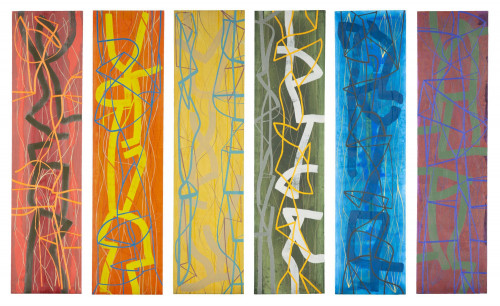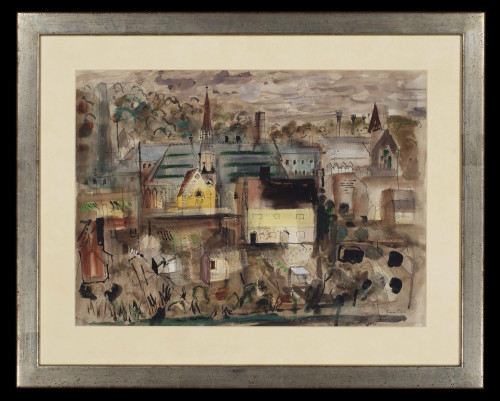Paul Nash, Haystack, Oxenbridge Farmhouse, Iden, Watercolour, Paper, 1923, Redfern
11141
PAUL NASH (British, 1889-1946)
Haystack at Oxenbridge Farmhouse, Iden
Signed and dated 'Paul Nash/1923' (lower left)
Pencil and watercolour
PROVENANCE : Private Collection. The estate of the late Miss Rose Adeane. The Redfern Gallery, Haystacks at Rye London, no.419 label undated.
Sheet height 54 cm., 21 ¼ in., Length 37 cm., 14 1/2 in.
Floated in a gilded, ogee, carved frame
Frame Height 71 cm., 21.75 in., Length 52.50 cm., 21.75 in.,
SUMMARY
For Nash, the 1920's was a period of country living and he produced some of his loveliest watercolours in the woods and fields and on the coast of Kent and Sussex where he lived. In this work you can feel how Nash's imagination was touched by the sensual qualities of light and shade, and the force and sound of the wind, as he translates the visual evidence into a more poignant composition. This picture with its soft, lyrical, pastoral depiction of Oxenbridge Farmhouse evokes the essence of rural life alongside the impact of war on this and the artist himself through his subtle contrasting in the scale, texture, palette and arrangement of the leaning haystack and the spiralling wind. This work portrays Nash's deep love and appreciation for nature, as well as a strong sense of place which related to both the external appearance, and what lies beneath, the history and emotions that are within particular landscape.
SIGNIFICANCE
This picture is Nash's first, known, depiction of Oxenbridge which was the home of close friends and artistic colleagues who he and wife Margaret regularly visited and the tithe cottage on the farm would two years later become their home. He masterfully conveys the 'sense of place' in his characteristically, lyrical depiction of the farmhouse, track and tree on the horizon in a soft, freely executed, light, muted palette. The spiralling wind over the roofline and the 'haystack' on the right introduce a layered, visual narrative representing the affect of war on this landscape and those who live there. This layering is characteristic of places that Nash was drawn to return to in which he imbued symbolic qualities within features of the rural landscape, creating significant and repeated inspirations and themes for his oeuvre and possibly seeking peace within himself. Writing in Country Life in 1938 Nash describes how a change of perspective or the appreciation of overlooked objects and natural features could allow the viewer to experience familiar landscapes in a new way. Using the wind and the haystack to portray an estranged sense of unreality within the representation of the landscape is an example of the significant and profound influence that Nash exerted over artists throughout the twentieth century and beyond. Creating another narrative and layer of meaning in the work including the impact of the artist's experience of WW1 which in-turn becomes more subjective through the epoch, lens and perspective of the viewer's reading. This picture represents a rare opportunity to acquire a work by one of Britain's greatest landscape painters who played a key role in the development of Modernism in English art featuring characteristics that are significant to his oeuvre and his influence on the art world.
He
COMPOSITION
Nash has reduced the features within the landscape to the spiralling wind over the north elevation of the farmhouse, the track, the tree on the horizon and the haystack. The path dissects the lyrical representation of the farmhouse and landscape symbolising home and safety, including the spiralling wind as a symbol of resilience affecting, moving through and emerging from a powerful force beyond control such as the war. The path intersects and takes us past the farmhouse and the haystack, winding its way through the centre of the composition leading the eye toward the tree on the horizon creating spaciousness in the composition, symbolising freedom. The haystack dominates the other side of the path looming over and leaning towards the farmhouse in darker tones symbolising the threat and loss war represents.
TITLE
It is not known how this picture acquired the title ' Haystacks at Rye ' on the gallery label which is not dated and Redfern Gallery have not been able to supply any more information. The composition clearly depicts on the left the distinctive canted and thatched north elevation of Oxenbridge Farmhouse from the east incorporating the door and the brickwork and plaster finishes. Photographs taken by Nash in 1930 now in the Tate Gallery Paul Nash Archive show a track on the right running past the farmhouse with a tree on the horizon as depicted. Today there is a large black, painted barn, age unknown, opposite the house with a roofline of approximately the same height which could have been in situ in 1923. The structure on the right (the haystack that the label describes) is cylindrical and extremely high, leaning towards the farmhouse dominating the right side of the composition. It could represent a haystack or the barn or another agriculture structure in situ at the time and it alludes to the war which is a theme Nash explores when he revisits Oxenbridge in his oeuvre.
NASH & OXENBRIDGE FARM
After the war Nash became disorientated and called himself 'a war artist without a war' and in 1921 he suffered a severe nervous breakdown and, with his wife Margaret, moved to a cottage in Dymchurch on the south east coast of Kent on the edge of the Romney Marshes so he could recuperate. He was inspired by the landscape and the sea, the melancholy of the place suiting his post-war mood. His oeuvre concentrates on motifs he found along that part of the Kent coast, producing a volume of wood engravings (Places, 1922) and he started to paint some floral still lives. He painted at least two dozen pictures in both oil and watercolour at this time which he suggested had a therapeutic affect on him.
Nash was living at Pantile Cottage in Dymchurch when Haystack at Oxenbridge Farmhouse, Iden was executed. Oxenbridge Farmhouse an early-15th century, grade II* listed building (Listing NGR: TQ9165824567) was owned by close friends of the Nash's. Catherine (Kitty) Buchanan and her husband Bertram another war artist who had served in the artillery in WW1, retiring as a Colonel was a woodcut artist. Kitty was a member of the Romney Marsh Weavers, a co-operative with a weaving shed in a disused chapel on Peasmarsh Road where they used wool from sheep at Oxenbridge Farm at Iden which is almost due west from Dymchurch, across the Romney Marsh. During the early 1920's the Nash's regularly stayed with Bertram and Kitty Buchanan at Oxenbridge Farm, Iden, before moving to live at Oxenbridge Cottage in 1925. The Nash's rented the tithe cottage (across the road from the farm) until 1930 when they moved to New House, Rye. Nash revisited the landscape at Oxenbridge in his paintings of the late-1920's yielding important pictures. The celebrated Landscape at Iden 1929(Tate Gallery N05047) a symbolic narrative representing the losses of the war and the passing of his father in a distorted view from the back of Oxenbridge Cottage. Oxenbridge Pond 1927-8, (Birmingham Museums Trust 1950P12) representing the tranquility and peace Nash found in nature post war. Month of March 1929 (Tate Gallery T15590) depicting the view from Nash's studio at Oxenbridge Cottage. Woodstacks at Iden 1925-1931 (Private collection). There are also a number of photographs of Oxenbridge Farm and Catherine (Kitty) Buchanan taken at Oxenbridge Farm by Paul Nash in the Tate Collection.
PAUL NASH (1889-1946)
Regarded as one of Britain's greatest landscape painters Paul Nash's work is held in many public and private collections worldwide. Nash was a painter, designer, illustrator, photographer, writer and teacher. Born in London, he was the brother of the artist John Nash. He studied at the Slade School and was given early encouragement by William Rothenstein. Nash worked with Roger Fry at Omega workshops and became a member of Friday Club and LG, NEAC and SWE. After serving with Artists' Rifles during World War I Nash was appointed official war artist. He subsequently taught at the Royal College of Art. Nash illustrated books between the wars including Urne Buriall and The Garden of Cyrus.
PAINTINGS IN MUSEUMS AND PUBLIC ART GALLERIES : UK
Fitzwilliam Museum, Cambridge, UK
National Galleries of Scotland, Edinburgh
The Royal Collection, London, UK
Aberdeen Art Gallery and Museums, Scotland
Ashmoleum Museum
National Museum Wales, Cardiff
Birmingham Museums Trust
Bolton Art Gallery, UK
Brighton & Hove Museums, England
British Museum
Courtauld Institute of Art, London, UK
Imperial War Musuem
Glynn Vivian Art Gallery, Swansea, Wales
Manchester City Art Gallery, UK
National Museums Liverpool, UK
Leeds Museums and Galleries
Tate Gallery, London, UK
Tyne & Wear Museums, England
Victoria and Albert Museum Catalogue, London, UK
Whitworth Art Gallery, Manchester, UK
PAINTINGS IN MUSEUMS AND PUBLIC ART GALLERIES : WORLDWIDE
MOMA, New York
Art Institute of Chicago
The Huntington Library, California
Harvard University Art Museums, Massachusetts
Cleveland Museum of Art, Ohio
Wichita Art Museum, Kansas
Beaverbrook Art Gallery, New Brunswick
National Gallery of Canada, Ottawa
Art Gallery of New South Wales, Sydney, Australia
20th Century
1923
Paper,Watercolor,Pencil
Collectors
Modern
Commemorative
EXCELLENT
1





















